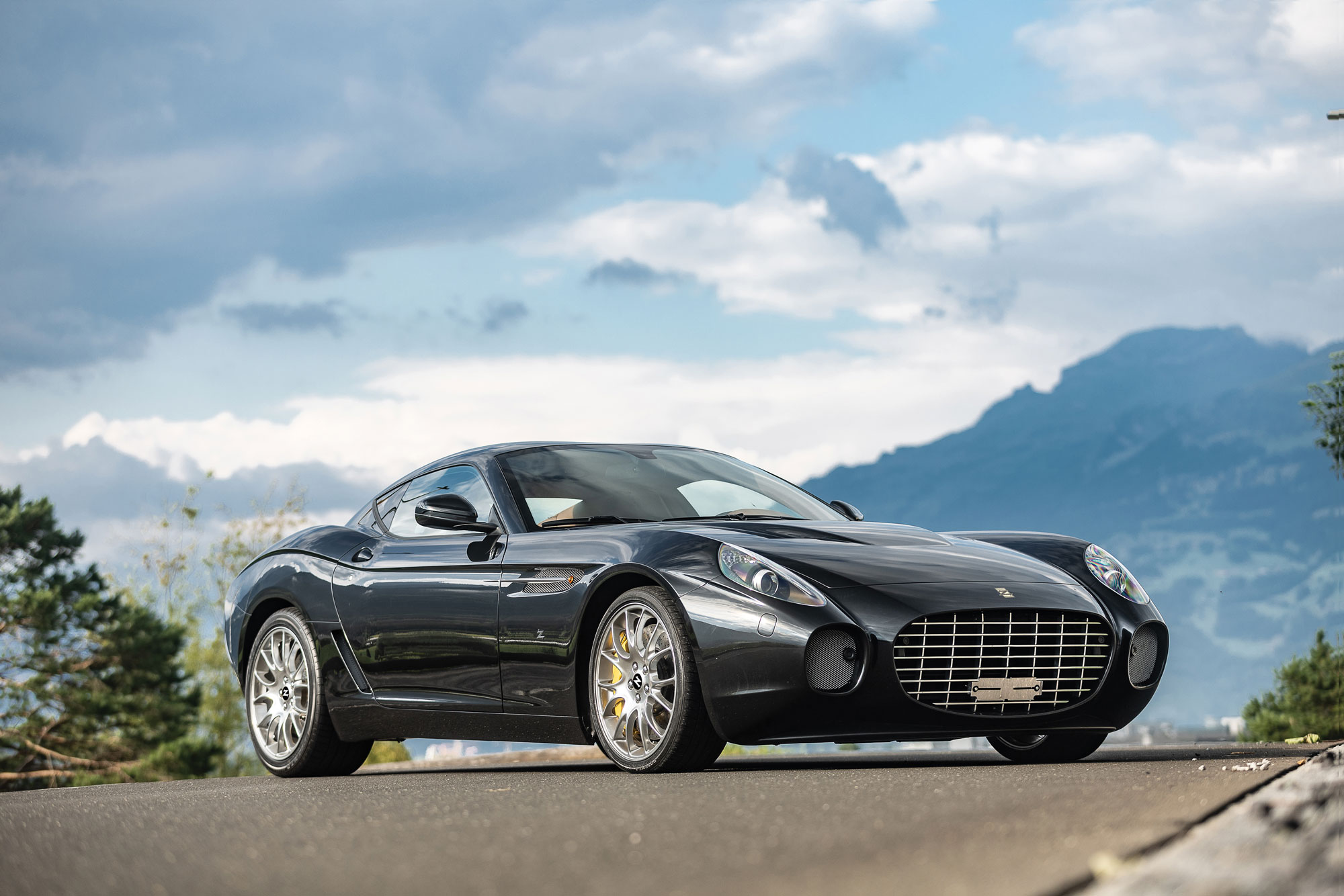Wearing bespoke carbon-fiber bodywork by Zagato, this stunning GTZ Nibbio is one of just nine to be restyled by the famous Italian coachbuilder. The current owner commissioned the build in GTZ specification after buying the vehicle in 2015. The work was completed in late 2016; the final bill was no less than €750,000, reflecting the painstaking levels of craftsmanship involved in creating this extraordinary machine.
Chassis 164839 was initially constructed in November 2008 wearing standard Pininfarina bodywork. Powered by a 6.0-liter V12 producing a phenomenal 612 horsepower, the car was capable of reaching 100 km/h in a scant 3.7 seconds. Its top speed exceeded a frightening 330 km/h (205 mph).
During the conversion, the structural elements of the original car’s design remained unchanged. The characteristic Zagato “double-bubble” roof is a key feature of the Nibbio. Its attractive tan leather interior, finished in a quilted pattern on the seats and around the footwell, combines with the numerous applications of carbon trim and modern switchgear. A stunning car that relives the golden age of coachbuilt thoroughbreds, this remarkable GTZ Nibbio has seen little use since conversion and would make an outstanding addition to any serious collection.
SCM Analysis
Detailing
| Vehicle: | 2008 Zagato GTZ Nibbio |
| Years Produced: | 2006–10 |
| Number Produced: | 9 “Zero Project” Ferrari Zagato GTZs; 9 Zagato GTZ Nibbios |
| Tune Up Cost: | $4,000 |
| Chassis Number Location: | Frame rail, passenger’s side of engine compartment |
| Engine Number Location: | Passenger’s side of engine in front, near where the head meets the block |
| Club Info: | Ferrari Club of America |
| Website: | http://www.ferrariclubofamerica.org |
| Alternatives: | 2006–08 Bentley Continental GTZ, 2011 Ferrari 599 GTO, 2012 Aston Martin V12 Zagato |
This car, Lot 121, sold for $848,083 (CHF 815,000), including buyer’s premium, at RM Sotheby’s auction in St. Moritz, Switzerland, on September 9, 2022.
When is a Ferrari not a Ferrari? When it has been modified from its original configuration. Ferrari is quite particular about the cosmetic appearance of its cars. It likes them to remain as they looked when they left the factory, and the company gets testy when someone makes one “their own.” It is understandable that Ferrari does not like copycats and will try to shut down anyone that makes a car that looks too similar to one of its icons, but the company also goes after someone who puts their name on a modified Ferrari.
The Canadian electronic music producer Deadmau5 found that out when he put a Nyan Cat wrap on his Ferrari 458 Italia. He might have gotten away with the comical graphics, but when Ferrari found out he covered the Prancing Horse nose badge with a leaping-cat emblem, it strongly encouraged him to rethink his choice. It follows, then, if you want to replace the body of your Ferrari with custom coachwork, you had better remove any Ferrari identification.
Going to Zagato
Sometime in 2005, noted Japanese Ferrari collector Yoshiyuki Hayashi approached Zagato to commission a custom body for his 575M. Zagato is, of course, a legacy design studio from the golden age of Italian carrozzerie.
Ugo Zagato founded Zagato in 1919 and made his mark by adapting lightweight construction techniques learned in the aeronautics industry to the construction of automobiles. His signature design was a “Double Bubble” roof, which featured a raised roof section over the driver’s and passenger’s head, supposedly to allow clearance for wearing a helmet.
Zagato had designed and built Double Bubble bodies for a couple of 1956 Ferrari 250 GT LWB Berlinetta Tour de France cars, one of which became Hayashi’s muse. Zagato accepted the commission and assigned the project to Norihiko Harada, its chief designer.
Proceeding under the code name “Zero Project,” Hayashi’s commission was expanded to include the rebodying of six Ferrari 575 GTs and three Ferrari 550 Barchettas. While each example was unique, they all featured Zagato styling notes, such as a bulbous nose, wide grille, powerful rear haunches and the Double Bubble roof. The conversions cost somewhere in the realm of $750,000, not including buying the donor car.
Enter Ferrari
A project of this magnitude, done in Italy, was certain to draw the attention of Ferrari. Seizing the opportunity to celebrate the 50th anniversary of the 250 GTZ, Ferrari agreed to Zagato proceeding with the nine Zero Project GTZs. From there, the details start to get muddy.
Note that in the catalog description for our subject car, there is no use of the Ferrari name. RM Sotheby’s simply calls the car a “2008 Zagato GTZ Nibbio.” The source of the chassis is not mentioned, nor is the manufacturer of the engine. However, the VIN decodes to a Ferrari 599, which matches the description of the 6-liter V12 engine. This makes it rather obvious that the Nibbio is the successor to the 550/575 Ferrari GTZ.
While the 550/575 GTZs wore Ferrari badges, there are no such items on our subject car. The nose badge, wheel centers, steering wheel and fender badges are all Zagato, as are the logos embroidered in the seats. We are left to deduce that a memo from Ferrari suggested an identity change.
Kicking everything but the tires
The success of Zagato’s GTZ conversion is controversial. SCM Contributing Editor and designer Robert Cumberford critiqued the 550 GTZ Barchetta’s styling in the March 2011 issue. In summary, he disliked everything but the tires. “It looks more like a badly customized Corvette than an Italian thoroughbred with impeccable provenance,” he wrote.
I find some of the criticism of the GTZ to be overly harsh, especially with respect to the better-looking coupe. The front does resemble a goldfish and the rear gives off definite Corvette vibes, but on the whole, the berlinetta is sporty and handsome. The GTZs are a good idea but one that doesn’t quite work. Replicating the bespoke models of the past with a modern car tends to result in an oddity rather than a trophy. A 599-based GTZ is not a Double Bubble 250 GT and never will be.
There is scant evidence on Zagato GTZ pricing, as they have rarely changed hands publicly. We have tracked only two other sales, and neither was timely. Two no-sales were reported with $1.5m and $1.1m high bids. Another no-sale with an unreported high bid had a $1.4m–$1.5m estimate. SCMers Tomini Classics in Dubai, UAE, had a 599 GTZ Nibbio berlinetta advertised at $1.5m, which sold not long ago, but at an unknown price. What is clear is that you can buy a GTZ for less than it would cost to commission one, which you may still be able to do so if you want to spend the money.
On a different day, this car might have made a higher price. But short of two determined bidders, the seller did okay, given that the estimate was $780k–$937k. The buyer may think they got a deal, but when it comes time to sell, finding another buyer won’t be easy. Regardless, nobody got hurt here. ♦
(Introductory description courtesy of RM Sotheby’s.)




